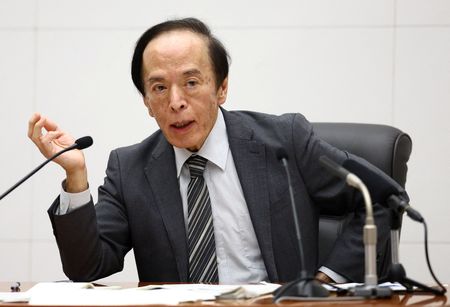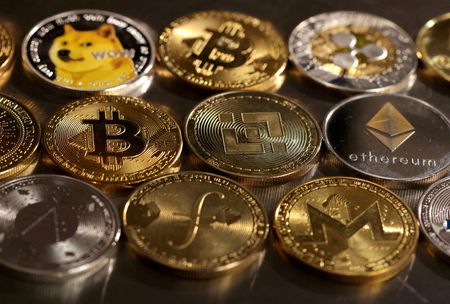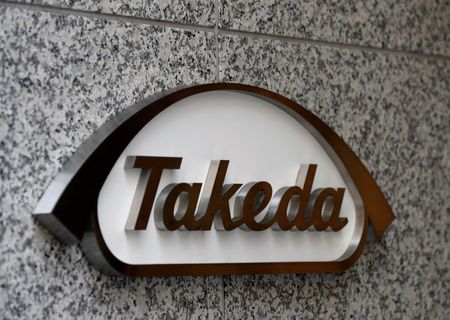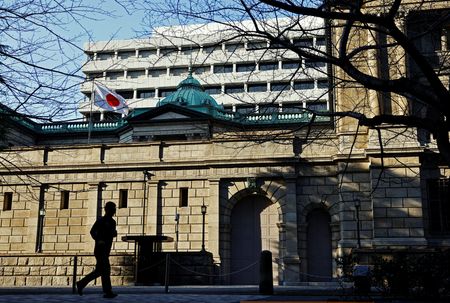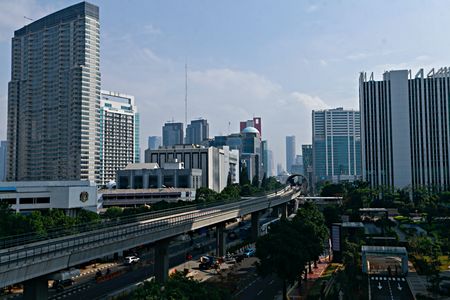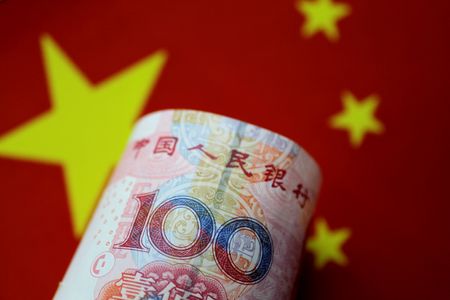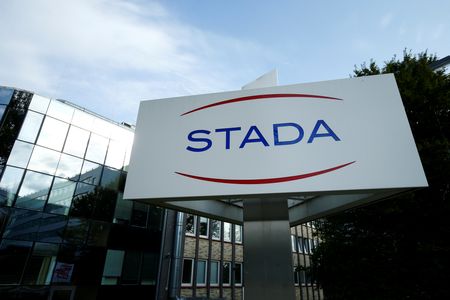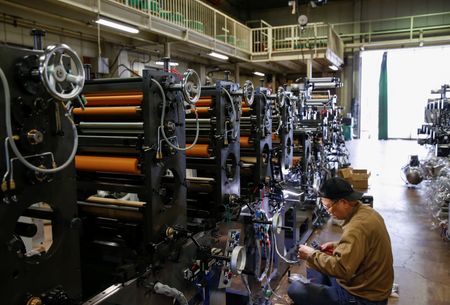By Leika Kihara
TOKYO (Reuters) -In 2024, Kazuo Ueda delivered Japan’s first interest rate hike in 17 years, a bold shift for a central bank once dominated by advocates of ultra-loose monetary settings – now, the Bank of Japan head is among the policy board’s least hawkish members.
The 73-year-old governor will attend the Federal Reserve’s Jackson Hole annual symposium this week, where Chair Jerome Powell’s assessment of the American economy and hints on the next U.S. rate cut will be factors in Japan’s own deliberations.
Ueda has become one of the more cautious members of the BOJ’s nine-member board in recent months and his concerns about the economic impact of U.S. tariffs are likely to provide some restraint among his fellow policymakers who are calling for more rate hikes, analysts and sources say.
An analysis in the BOJ’s recent outlook report in part underscores his caution over the expected hit to Japan’s economy from tariffs that could complicate its decision around the timing of the next rate hike.
“Japan’s trade deal with the U.S. reduced, but did not eliminate, uncertainty over tariffs,” said a source familiar with the central bank’s thinking, a view echoed by another source. “It’s too early for the BOJ to be optimistic on Japan’s economy.”
Ueda has faced growing calls from within his board to pay more attention to mounting inflationary pressure in Japan’s once deflation-prone economy.
A U.S. rate cut could push up the yen against the dollar, which may ease concern about the inflationary impact of a weak yen – but could hurt exporters’ profits depending on the pace.
Stubbornly high food inflation has led some BOJ board members to warn of second-round price effects that could warrant another rate hike, a summary of the bank’s July meeting showed.
The hawkish signals contrast with Ueda’s post-meeting comments justifying going slow on rate hikes on the view underlying inflation, which focuses on domestic demand and wages, remains below the BOJ’s target.
“Governor Ueda appears to pay particularly close attention to the U.S. economy,” said former BOJ board member Takahide Kiuchi. “If he becomes more convinced that the U.S. economy will stabilise, the BOJ could eye a rate hike this year.”
CIRCLE OF HAWKS
On the surface, the hawks appear to be gaining an upper hand.
Among current board members, three – Naoki Tamura, Hajime Takata and Junko Koeda – are seen by markets as hawks due in part to their recent comments warning that rising food prices could risk leading to broader-based, sustained inflation.
Deputy governor Ryozo Himino, who once warned that keeping real interest rates negative for too long would be “abnormal”, is considered the most hawkish among the BOJ’s leadership.
By contrast, the doves, who dominated the board when Ueda’s predecessor Haruhiko Kuroda deployed a massive stimulus in 2013, have seen their presence and voice diminished.
Toyoaki Nakamura, who voted against a rate hike in January, retired in June and was succeeded by Kazuyuki Masu, who is seen as taking a neutral stance on policy. Once a fan of heavy money printing, Asahi Noguchi has also turned more neutral and voted for raising rates in January.
Such shifts in the board’s policy bias put Ueda and his career central banker-turned deputy Shinichi Uchida in the more dovish camp, as their comments continue to focus on downside risks to Japan’s fragile economy.
Their caution reflects the BOJ’s preference to await more data to gauge whether the global economy, including Japan’s, will withstand the hit from U.S. tariffs, say sources familiar with the bank’s thinking.
It also reflects lingering worries within the BOJ that the damage to exports and capital expenditure will intensify in coming months – as predicted by the bank’s economists.
In analyses included in the July quarterly outlook, BOJ economists warned company profits are likely to fall this year because of U.S. tariffs, hurting capital expenditure.
There is good reason to worry. While Japan’s trade deal with the U.S. agreed to cut tariffs for its mainstay auto exports, Washington has not made clear the timing of the reduction.
Many analysts expect exports, which lifted Japan’s second-quarter GDP, to lose momentum later this year as the hit from U.S. tariffs deepens.
Even hawkish board members warn such risks could warrant caution on rate hikes.
“We need to scrutinise whether any negative impact from U.S. tariffs could appear,” board member Takata said in a speech on July 3.
Despite the board’s hawkish tilt, Ueda’s cautious stance may prevail given the influence the governor holds over BOJ decision making.
With support from staff of key divisions, the governor prepares proposals on policy and interest rates for a vote by the board. Most have been approved unanimously or by a majority, including the BOJ’s exit from a decade-long stimulus last year.
The governor’s proposal has never been voted down since the current board framework took shape in 1998.
“I don’t see any tough negotiator in the current board who could stage a revolt. It’s hard to imagine the hawks proposing a rate hike against the governor’s will,” said former BOJ official Nobuyasu Atago, who used to be staff for hawkish ex-board member Miyako Suda.
“Governor Ueda’s leadership within the board appears to be fairly strong.”
(Reporting by Leika Kihara; Editing by Sam Holmes)

